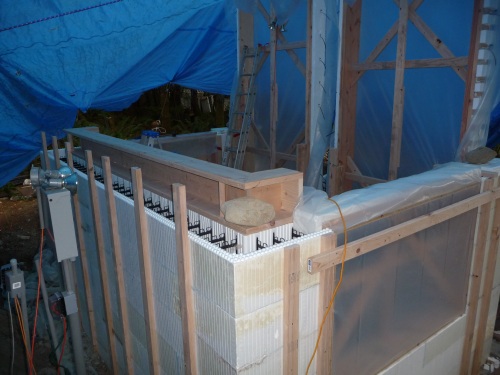Home Site Map - Techniques - Structure -
Balconies
![]() Make sure your balconies are not heat loss radiator fins, yet are
structurally sound.
Make sure your balconies are not heat loss radiator fins, yet are
structurally sound.
Why are they hard
From a building science perspective, having balconies is a really bad idea. Unfortunately it is just too appealing to have somewhere high up outside to sit so you can enjoy the view of your yard and beyond. Somehow we need to find a way to make them work. The issue is that balconies need to be structural, ie able to safely take your weight, but making them structural extensions to your house structure potentially makes them into radiator fins that will cool your house, ie raise your heating bill.
Sometimes a balcony is really what some people would call a deck. Whatever it's called, sometimes it will have conditioned living space underneath and sometimes it will be outside air underneath. All these situations have to be considered and handled using good building science principles. If the structure of the balcony/deck is made of a thermally conductive material (such as concrete), then an important question is whether the concrete will be kept at the internal house temperature or be thermally isolated to be at the external air temperature. The notes below refer to concrete balconies/decks and how to handle them.
Concrete balconies/decks with outside air underneath
If you just extend the concrete floor of the house out past the wall to form a balcony then the concrete of the balcony will be at about the same temperature as the inside of your house, ie at whatever temperature you've set your thermostat to. You would need to heavily insulate the concrete of the balcony in order to prevent the heat loss associated with it being like the fin of a radiator. Even with lots of insulation underneath, at the end, and on top, you will still loose some heat because heat loss is proportional to surface area.
Somehow you need to thermally isolate the concrete of the balcony from the concrete of the house. Unfortunately materials that are good at providing the necessary structure to hold the balcony up also tend to be thermal conductors. The bottom line is that if you are going to use a thermal isolator (eg a thick rubber block) then you cannot really cantilever the balcony off the house structure, ie you need to find some other way to hold the balcony up. The best solution is to use columns on the balcony. These can independently transfer the weight of the balcony and the people on it down into the foundations. Of course you still need to make a connection to the house to stop the balcony and column assembly from toppling over, but this is easily achieved using non thermally conductive composite rebar, eg fiberglass or basalt rebar.
The following diagram shows the three principle elements of the design.
There are 2" thick rubber blocks to provide thermal insulation between the house concrete and the balcony concrete. Blocks like this are used on road bridges to reduce vibration (and they are even used in the foundations of Carnegie Hall). As well has providing a thermal break, they also can transfer the weight of the inside edge of the balcony into the house structure. Note that supporting some weight is very different from providing a cantilever.
Just above the rubber blocks is the composite fiberglass/basalt rebar that is used to tie the balcony to the house. Like the rubber, the fiberglass/basalt rebar is a thermal insulator. The rebar stops the balcony pulling away from the house. Again note that it is not trying to provide a cantilever.
The last critical aspect is the columns. They support the bulk of the weight of the balcony. It is supporting the outer edge of the balcony that is the most important. The columns can also be made out of concrete and as with the balconies, the concrete will be at outside air temperature rather than inside house temperature. Typically they will have their own concrete foundations so again there is not heat loss from the actual house.
Finishing off
Because the concrete of the balcony is thermally isolated from the concrete of the house there is no need to provide insulation round the concrete. There is however a need to provide a slope to allow water to run off. The actual concrete will be a level surface so we need to separately form a slope on top. The easiest way is to use a wedge of EPS. EPS sheets are always cut from a block using a hot wire cutter so it is possible to get the sheets custom cut to instead be a wedge shape. Over the sloped EPS goes a 6 mil polyethylene sheet. This is a continuation of the polyethylene sheet that is part of the wall assembly. On top of the polyethylene sheet it is good to add a 1" sheet of EPS to hold the polyethylene sheet in place and generally protect it. A layer of black filter fabric on top stops dirt going down between the gaps and hides the glaring white of the EPS. A level walkway made of cedar planks can then be implemented over the top (using cut to size support blocks to get the walkway level even though it is sitting on a sloped surface.
On the underside of the balcony, there is the EPS of the Carnation Flooring that was used to provide the mold for the wet concrete. There is no need for a polyethylene sheet on the underside as it is not hit by rain water, so just a stucco finish is applied.
What if the columns need to be above conditioned space?
The typical situation is that the columns supporting outside air temperature balconies go down to their own foundations that are also at the outside temperature. Sometimes though, such as is the case with my porticos that have some conditioned living space in the base, the columns come up from the top of a harm area. In this case it is necessary to thermally isolate at the base of the column. The same is also true for the top of a column that holds up an area of conditioned space. This thermal isolation can also be provided using rubber blocks and fiberglass/basalt rebar as shown in the diagram below.
Concrete balconies/decks with conditioned living space underneath
Sometimes a deck area is above a conditioned living space, ie the deck area is really just the roof of the living area. In my case the roof of the conditioned space is a concrete roof. It is formed using the Carnation Flooring polystyrene forms which form the concrete into beams and an overall concrete top surface. The concrete of the roof, ie the concrete of the deck, will be at inside house temperature. As such it is necessary to have insulation on the outside of the concrete, ie on top of the concrete, in order to stop the concrete loosing heat (that would increase your heating costs). You will need about 4" of polystyrene over the roof/deck area.
High density EPS is fine for taking the weight of hundreds of people on your deck, but it cannot be the actual walking surface. A good solution is to use cedar wood planks to provide the actual walking surface (cedar is highly rot resistant). To provide a drainage surface it is necessary to provide a slope so the water can run away, but it is a pain walking on an un-level surface. The best solution is to have gaps between the planks of the walking surface so that the water can fall through to a sloped surface underneath.
The concrete of the roof structure will be completely level. The planks of the deck will also be completely level. The drainage slope comes from making the EPS insulation slightly wedge shaped. Groves can also be cut into the top surface of the EPS to further promote good water channeling. Even though the EPS sheets are fairly water impenetrable, a sheet of polyethylene is necessary to make a completely water tight sloped surface.
The question is - where should the polyethylene sheet be placed. Ideally the water and vapor barriers should be on the warm side of the insulation rather than on the top cold surface. The problem is that the waterproof layer provided by the sheet needs to be sloped to provide the water run-off, so it cannot go straight onto the flat concrete surface. The rough concrete would also damage the polyethylene sheet. The best engineering compromise is to use a sloped layer of EPS on top of the concrete (varying from 1/2" to 3" thick), then lay the polyethylene sheet, then put a layer of uniform 2" thick EPS on top. The top 2" sheet of EPS will be wetted by the rain. EPS can withstand being permanently wet, so that's ok. Some of the rain will run away on the top surface of the 2" EPS sheet and some rain will come through the gaps between the 2" sheets and get caught by the polyethylene sheet layer. A dimpled drain mat (dimples pointing up) should be used between the polyethylene sheet and the 2" EPS sheet above so that there's a drainage gap.
On top of the 2" thick sheet of EPS, filter fabric should be used. This has two functions. First it stops dirt from getting to the dimple mat and clogging it up. Secondly the fiber fabric should be black and this will stop the unsightly white of the EPS being visible through the gaps between the walkway planks.
The following diagram shows the complete cross section.
Even though theoretically per simple building science rules it is best to have the insulation completely on top of the water barrier, in practice it is good to also have some insulation under the water barrier. If the rain water was able to flow all the way through the insulation layer then it would contact the warm concrete and carry away some of the warmth from the concrete. The solution described that has some insulation above and some below the water barrier represents a good engineering compromise.
Even though it won't do any harm having water trapped between the polyethylene sheet and the concrete it is still best to try to avoid this. As such it is best to lay the sloped EPS and the polyethylene sheet on a dry day.
Note that on the underside of the concrete roof (that is the concrete deck) is the EPS of the Carnation Flooring. This EPS does not count as insulation because the concrete is kept at close to interior house temperature so there is virtually no temperature gradient across the EPS. The EPS of the Carnation Flooring is purely to form the mold for the wet poured concrete.
Railings
What if the railings are attached to conditioned space structure?
If there is a concrete ledge to support a wooden floor or thermally isolated balcony or decking then the vertical bracing will need to be cut to a length such that it comes up to (and supports) the bottom of the box that forms the concrete ledge. Lumber is table sawn to 9" wide, which with the 2-by top and bottom makes it 1 foot high which is the same as an ICF block. The top and bottom lumber is table sawn to be 8-1/8" wide, which means the lip sticks out 5-1/2" beyond the outside edge of the ICF EPS. Bits of 2x4 are attached top and bottom to keep it in line with the ICF blocks that are under and over "wooden block" assembly.
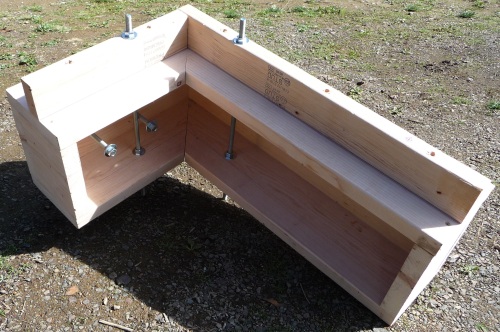

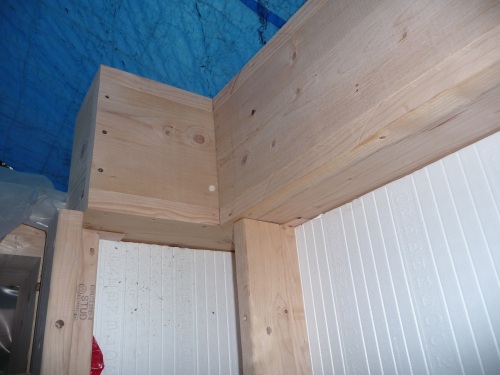
Cut the shims from some spare 2-by lumber. Just cut random widths and then you can pick the width that works.
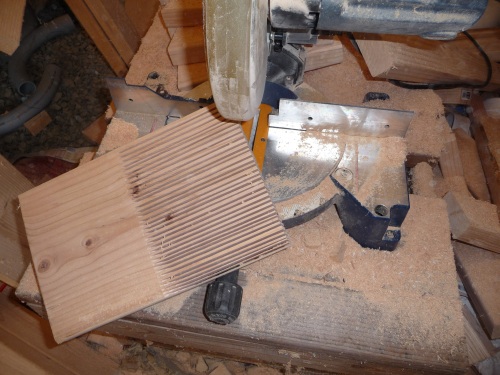
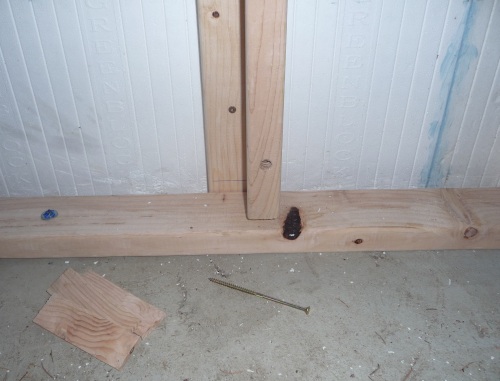

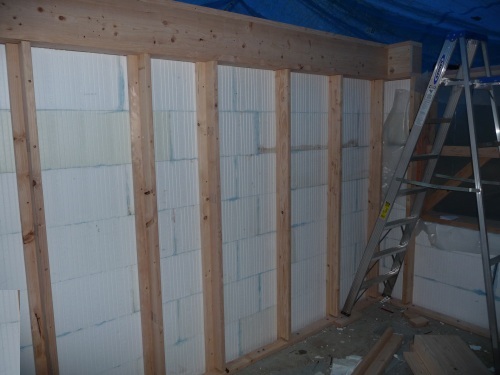
Where there is a concrete lip on just one side of the wall, the vertical batons on the other side should be made longer (eg 8' instead of 7') in order to take the other end of the horizontal 1/2"studding.
